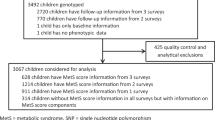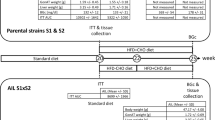Abstract
Objective:
The NHLBI Family Heart Study (FHS) genome-wide linkage scan identified a region of chromosome 7q with a logarithm of odds score of 4.9 for body mass index (BMI).
Design:
We report the results of fine mapping the linkage peak using 1020 single nucleotide polymorphisms (SNPs) to test for association to obesity in families exhibiting linkage to chromosome 7. Association observed in linked families (284 obese cases/381 controls) was examined in an independent set of unrelated FHS participants (172 obese cases/308 controls) to validate the observed association. Two dichotomous obesity phenotypes were studied based on clinical BMI cutoffs and the sex-specific distribution of both BMI and leptin levels.
Results:
Using a P-value of 0.01 as criteria for association in the linked families, a P-value of 0.05 as criteria for association in the unrelated sample, and requiring consistency in the direction of the effect of the minor allele between the two samples, we identified two coding SNPs in the NYD-SP18 gene with minor alleles increasing the risk of obesity. Adjustment for exercise, smoking and FTO genotype did not influence the result in linked families, but improved the result in the unrelated sample. Carrying a minor allele of the nonsynonymous SNP rs6971091 conferred an odds ratio of at least 2 for obesity defined by both BMI and leptin levels.
Conclusion:
The effect of the NYD-SP18 SNP on obesity was larger than the effect of FTO in FHS families. Publicly available results from genome-wide association studies support the association between NYD-SP18 and BMI. The NYD-SP18 gene is described as testes development related, but little is known about the gene's function or the mechanism by which it may influence risk for obesity.
This is a preview of subscription content, access via your institution
Access options
Subscribe to this journal
Receive 12 print issues and online access
$259.00 per year
only $21.58 per issue
Buy this article
- Purchase on Springer Link
- Instant access to full article PDF
Prices may be subject to local taxes which are calculated during checkout

Similar content being viewed by others
References
Feitosa MF, Borecki IB, Rich SS, Arnett DK, Sholinsky P, Myers RH et al. Quantitative-trait loci influencing body-mass index reside on chromosomes 7 and 13: the National Heart, Lung, and Blood Institute Family Heart Study. Am J Hum Genet 2002; 70: 72–82.
Li WD, Li D, Wang S, Zhang S, Zhao H, Price RA . Linkage and linkage disequilibrium mapping of genes influencing human obesity in chromosome region 7q22.1–7q35. Diabetes 2003; 52: 1557–1561.
Platte P, Papanicolaou GJ, Johnston J, Klein CM, Doheny KF, Pugh EW et al. A study of linkage and association of body mass index in the Old Order Amish. Am J Med Genet 2003; 121: 71–80.
Jiang Y, Wilk JB, Borecki I, Williamson S, DeStefano AL, Xu G et al. Common variants in the 5′ region of the leptin gene are associated with body mass index in men from the National Heart, Lung, and Blood Institute Family Heart Study. Am J Hum Genet 2004; 75: 220–230.
Paracchini V, Pedotti P, Taioli E . Genetics of leptin and obesity: a HuGE review. Am J Epidemiol 2005; 162: 101–114.
Yang W, Kelly T, He J . Genetic epidemiology of obesity. Epidemiol Rev 2007; 29: 49–61.
Elbers JM, Asscheman H, Seidell JC, Frolich M, Meinders AE, Gooren LJ . Reversal of the sex difference in serum leptin levels upon cross-sex hormone administration in transsexuals. J Clin Endocrinol Metab 1997; 82: 3267–3270.
Frayling TM, Timpson NJ, Weedon MN, Zeggini E, Freathy RM, Lindgren CM et al. A common variant in the FTO gene is associated with body mass index and predisposes to childhood and adult obesity. Science 2007; 316: 889–894.
Dina C, Meyre D, Gallina S, Durand E, Korner A, Jacobson P et al. Variation in FTO contributes to childhood obesity and severe adult obesity. Nat Genet 2007; 39: 724–726.
Scuteri A, Sanna S, Chen WM, Uda M, Albai G, Strait J et al. Genome-wide association scan shows genetic variants in the FTO gene are associated with obesity-related traits. PLoS Genet 2007; 3: e115.
Saxena R, Voight BF, Lyssenko V, Burtt NP, de Bakker PI, Chen H et al. Genome-wide association analysis identifies loci for type 2 diabetes and triglyceride levels. Science 2007; 316: 1331–1336.
Fox CS, Heard-Costa N, Cupples LA, Dupuis J, Vasan RS, Atwood LD . Genome-wide association to body mass index and waist circumference: the Framingham Heart Study 100K project. BMC Med Genet 2007; 8: S18.
Fingerlin TE, Boehnke M, Abecasis GR . Increasing the power and efficiency of disease-marker case-control association studies through use of allele-sharing information. Am J Hum Genet 2004; 74: 432–443.
de Bakker PI, Yelensky R, Pe’er I, Gabriel SB, Daly MJ, Altshuler D . Efficiency and power in genetic association studies. Nat Genet 2005; 37: 1217–1223.
World Health Organization. Obesity: preventing and managing the global epidemic. Report of a WHO consultation. World Health Organization technical Report Series 2000; 894 (i–xii): 1–253.
Cupples LA, Arruda HT, Benjamin EJ, D’Agostino Sr RB, Demissie S, DeStefano AL et al. The Framingham Heart Study 100K SNP genome-wide association study resource: overview of 17 phenotype working group reports. BMC Med Genet 2007; 8: S1.
Reumers J, Conde L, Medina I, Maurer-Stroh S, Van Durme J, Dopazo J et al. Joint annotation of coding and non-coding single nucleotide polymorphisms and mutations in the SNPeffect and PupaSuite databases. Nucleic Acid Res 2008; 36: D825–D829.
Rudiger S, Germeroth L, Schneider-Mergener J, Bukau B . Substrate specificity of the DnaK chaperone determined by screening cellulose-bound peptide libraries. EMBO J 1997; 16: 1501–1507.
Johnson JM, Castle J, Garrett-Engele P, Kan Z, Loerch PM, Armour CD et al. Genome-wide survey of human alternative pre-mRNA splicing with exon junction microarrays. Science 2003; 302: 2141–2144.
Soderberg S, Olsson T, Eliasson M, Johnson O, Brismar K, Carlstrom K et al. A strong association between biologically active testosterone and leptin in non-obese men and women is lost with increasing (central) adiposity. Int J Obes Relat Metab Disord 2001; 25: 98–105.
Cefalu WT, Pardridge WM, Chaudhuri G, Judd HL . Serum bioavailability and tissue metabolism of testosterone and estradiol in rat salivary gland. J Clin Endocrinol Metab 1986; 63: 20–28.
Acknowledgements
This study was supported by National Heart, Lung, and Blood Institute grants NHLBI RO-1 HL68891-06. This article is presented on behalf of the investigators of the NHLBI Family Heart Study.
Author information
Authors and Affiliations
Corresponding author
Rights and permissions
About this article
Cite this article
Wilk, J., Laramie, J., Latourelle, J. et al. NYD-SP18 is associated with obesity in the NHLBI Family Heart Study. Int J Obes 32, 930–935 (2008). https://doi.org/10.1038/ijo.2008.23
Received:
Revised:
Accepted:
Published:
Issue Date:
DOI: https://doi.org/10.1038/ijo.2008.23



